Explore Cho Gao District - Vietnam Travel, Asia
Nestled in the heart of the Mekong Delta, Cho Gao offers a blend of rich history, vibrant culture, and breathtaking landscapes. This hidden gem, located in Tien Giang Province, Vietnam, is an ideal destination for travelers seeking an authentic and immersive experience. With its winding rivers, lush rice paddies, and friendly locals, Cho Gao is more than just a stopover—it's a place to explore and enjoy. Whether you're a history buff, a foodie, or an adventurer, Cho Gao has something to offer.
Population: Approximately 186,000 in 2019.
Economy: Cho Gao's economy thrives on agriculture, particularly rice and fruit cultivation, alongside local handicrafts and small-scale trade. The district's vibrant markets and river transport support economic activities.
Landmarks: Famous for the Cho Gao Floating Market, Cho Gao Traditional Handicrafts Village, and Binh Hoa Phuoc Pagoda.
Vietnam
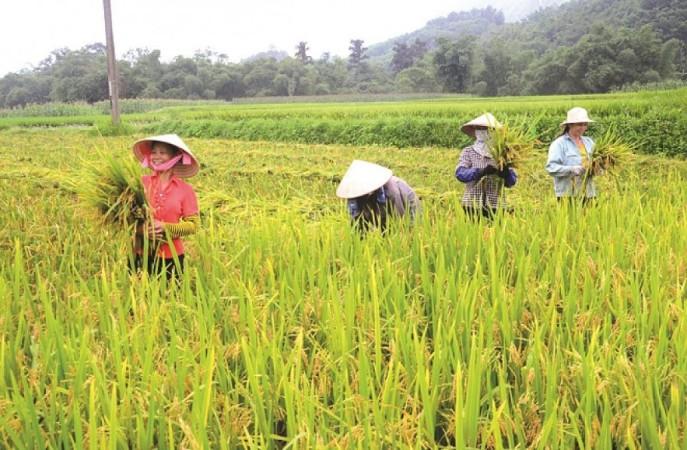
Overview of Cho Gao
History & Cultural Influence
Cho Gao’s history is a tapestry woven from diverse cultural threads. Over the centuries, this region has seen influences from various dynasties and colonial powers, each leaving an indelible mark on its culture and traditions. The town’s name, "Cho Gao," meaning “Rice Market,” reflects its historical role as a bustling trade hub in the Mekong Delta, where rice and other agricultural products were exchanged. The fusion of Vietnamese, Khmer, and Chinese influences can be seen in the local festivals, cuisine, and everyday life, offering visitors a unique glimpse into the region’s rich heritage.
Interaction with The Locals
Cho Gao is home to a population of around 186,000 residents, predominantly of Vietnamese ethnicity. The people of Cho Gao are known for their warm hospitality and deep connection to the land, with many families having lived in the region for generations. Agriculture, particularly rice farming and fruit cultivation, is a significant part of daily life, shaping both the local economy and cultural practices. The community is close-knit, with traditions passed down through the years, reflecting a harmonious blend of history, culture, and the simplicity of rural living.
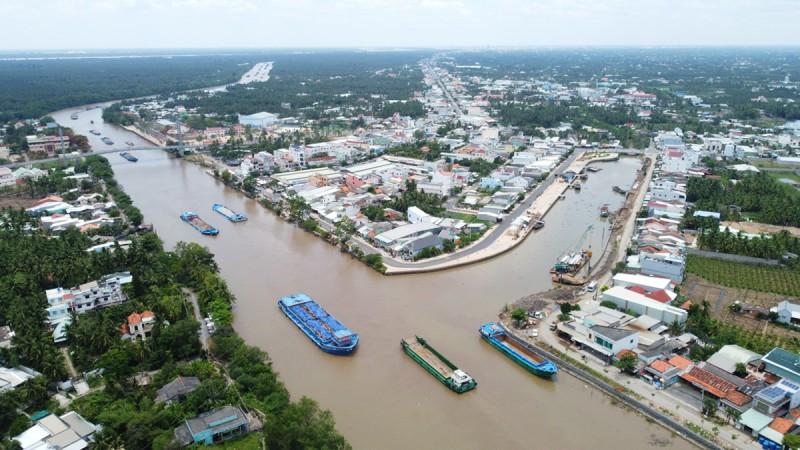
Cho Gao district - © VnExpress
Top Attractions in Cho Gao
Must-Visit Places in Cho Gao
- Cho Gao Floating Market: The Cho Gao Floating Market is a vibrant hub where local traders sell fresh produce, seafood, and traditional goods directly from their boats. The market offers a unique glimpse into the daily life of the Mekong Delta’s riverine communities.
- Cho Gao Traditional Handicrafts Village: Discover the traditional crafts of Cho Gao, including intricate embroidery, weaving, and pottery. Visit local workshops where skilled artists use generation-old traditions to make stunning handcrafted goods.
- Binh Hoa Phuoc Pagoda: This tranquil pagoda is renowned for both its quiet settings and elaborate design. The pagoda features beautiful sculptures, colorful murals, and a tranquil garden, making it a great spot for reflection and to gain insight into the spiritual practices of the local Buddhist community.
- Thoi Son Island: Accessible by boat, Thoi Son, also known as Unicorn Island, is a charming island. It’s famous for its lush gardens, traditional Vietnamese houses, and local crafts. Visitors can enjoy boat rides through the island’s canals, sample local honey, and witness traditional performances.
Hidden Gems in Cho Gao
- Fruit Orchards in Cho Gao: Visit the lush fruit orchards that thrive in Cho Gao’s fertile soil. These orchards grow a variety of tropical fruits, including mangoes, lychees, and longans. Wandering through the orchards, where you can sample fresh fruit straight from the tree and learn about the cultivation methods used by local farmers.
- Sac Forest Special Zone: This expansive mangrove forest is a haven for nature enthusiasts. The forest offers walking trails and boat tours through its maze of waterways, where you can spot various bird species, reptiles, and unique plant life. It’s a great place for eco-tourism and to experience the rich biodiversity of the Mekong Delta region.
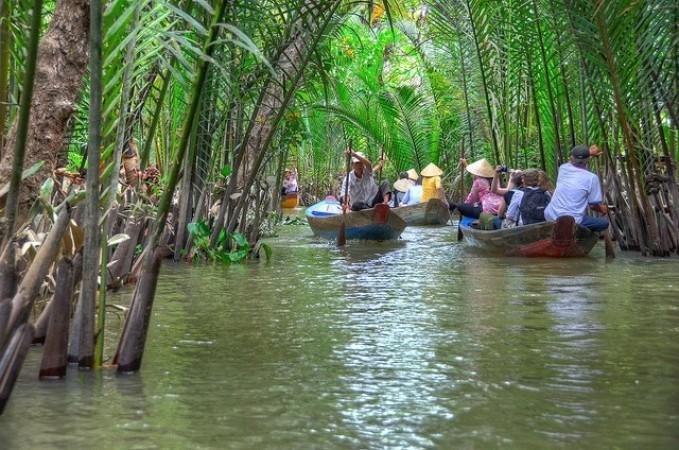
Thoi Son Island - © VietnamNews
Must-Try Dishes in Cho Gao
- Banh Xeo (Vietnamese Pancake): This crispy, savory pancake is a local favorite, made from rice flour and turmeric, and stuffed with shrimp, pork, and bean sprouts. It's typically served with fresh herbs and a tangy dipping sauce, providing a delightful contrast of textures and flavors.
- Hu Tieu (Vietnamese Rice Noodles): A regional variation of noodle soup, Hủ Tiếu in Cho Gao features tender rice noodles in a clear, flavorful broth, often topped with slices of pork, shrimp, and fresh vegetables. The broth, simmered for hours, is what makes this dish stand out.
- Ca Kho To (Clay Pot Catfish in Caramel Sauce): This traditional clay pot caramelized fish dish is a testament to the district’s connection to the Mekong River. The fish is slow-cooked in a savory-sweet sauce until it’s tender and infused with rich flavors, typically served with steamed rice.
- Goi Cuon (Vietnamese Spring Rolls): Fresh spring rolls made with rice paper, herbs, shrimp, and pork, served with a peanut dipping sauce, offer a light and refreshing option and a great appetizer or a quick snack.
- Lau Mam (Fermented Fish Hot Pot): This hot pot dish is another local favorite, featuring a fermented fish-based broth. It is usually served with rice noodles and a variety of meats, fish, and fresh vegetables that are prepared at the table.
- Banh Tet La Cam (Cam Leaf Pork Bean Sticky Rice Cake): A traditional sticky rice cake, Bánh Tét Lá Cẩm is unique to the Mekong Delta region. It's made of sticky rice, pork, and mung beans. After that, it is steam-cooked while covered in banana leaves. The distinctive purple color comes from the addition of magenta plant leaves.
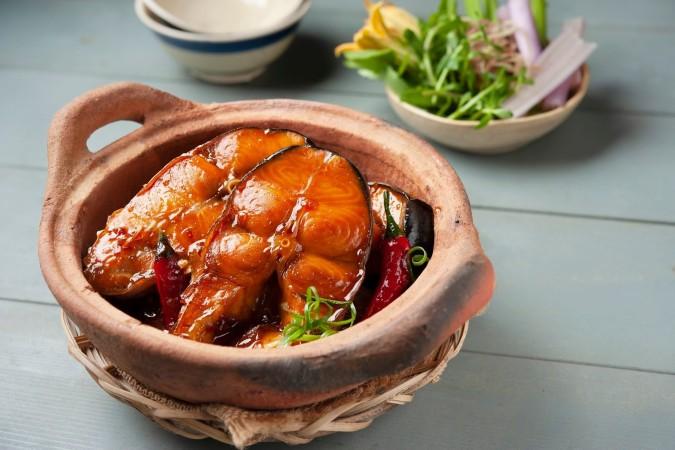
Ca Kho To (Clay Pot Catfish in Caramel Sauce) - © BASAmaster
Festivals & Local Celebrations
Cho Gao is alive with cultural festivals and celebrations that reflect the district’s deep-rooted traditions and vibrant community spirit. These events are an excellent way for visitors to immerse themselves in the local culture, witness traditional rituals, and participate in lively festivities.
Cultural Festivals in Cho Gao
- Tet Holiday (Lunar New Year): Cho Gao celebrates Tet, the most important festival in Vietnam, with enormous fervor. The district comes to life with traditional performances, feasts, and vibrant decorations. Families congregate to pay tribute to their ancestors, and music and joy fill the streets.
- Vu Lan Festival: Also known as the “Ghost Festival,” this is a time when locals pay respects to their deceased loved ones. Temples and homes are adorned with offerings, and ceremonies are held to pray for the spirits of the departed. It’s a deeply spiritual occasion that provides insight into the local belief system.
Seasonal Events in Cho Gao
- Harvest Festivals: Given Cho Gao’s agricultural roots, harvest festivals are common. These events celebrate the bounty of the land with communal feasts, traditional music, and dance. Alongside the locals, visitors may take part in the celebrations and feel the happiness that comes with a great harvest.
- Mid-Autumn Festival: The Mid-Autumn Festival is a fun festival for kids and adults alike, complete with lantern parades, mooncakes, and traditional lion dances. It’s a colorful and joyful event that lights up the night with festive energy.
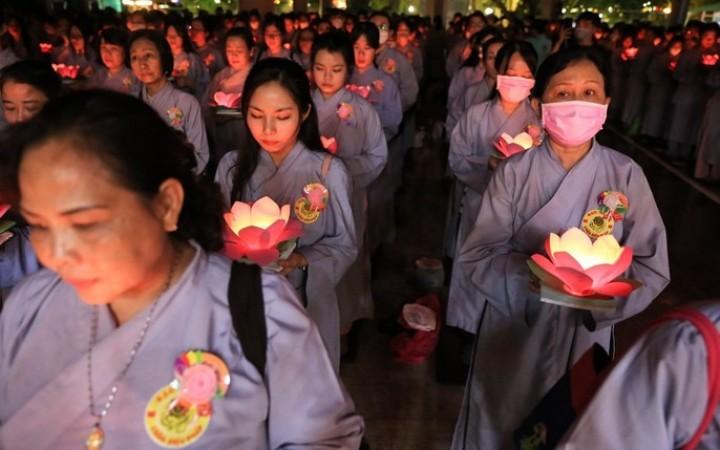
Vu Lan Festival - © Thanh Nien News
What to Do in Cho Gao
- Mekong River Cruises: The Mekong River is the lifeblood of Cho Gao, and a river cruise is the perfect way to explore it. These cruises take you through the district’s lush landscapes, past stilt houses, and floating markets, offering a unique perspective on life along the river.
- Cho Gao Cycling Tours: With its flat terrain and scenic countryside, Cho Gao is ideal for cycling. Rent a bike and explore the rural paths that wind through rice paddies, orchards, and quaint villages. It's a relaxing and eco-friendly way to explore the neighborhood.
- Fruit Orchard Visits: Cho Gao is known for its fruit orchards, where you can pick and taste fresh tropical fruits like durian, rambutan, and longan. These visits often include a tour of the orchard, allowing you to learn about the cultivation process.
Shopping in Cho Gao
Cho Gao’s Local Markets
- Cho Gao Market: The main market in the district is a bustling hub where you can find everything from fresh fruits and vegetables to handmade crafts. It’s a vibrant place to explore, with vendors eager to share their products and stories with visitors.
- Night Markets: For a different experience, visit one of Cho Gao night markets. After dusk, these marketplaces come alive with a wide selection of street food, apparel, and accessories. You may dine, buy, and watch live entertainment all in a bustling environment.
What to Shop in Cho Gao
- Handmade Crafts: Cho Gao is known for its skilled artisans who create beautiful handicrafts, including woven mats, pottery, and conical hats. These items make for perfect souvenirs that reflect the district’s rich cultural heritage.
- Local Specialty Foods: Don’t miss the opportunity to buy local delicacies like dried fruits, rice cakes, and fish sauce, which are popular gifts for friends and family back home.
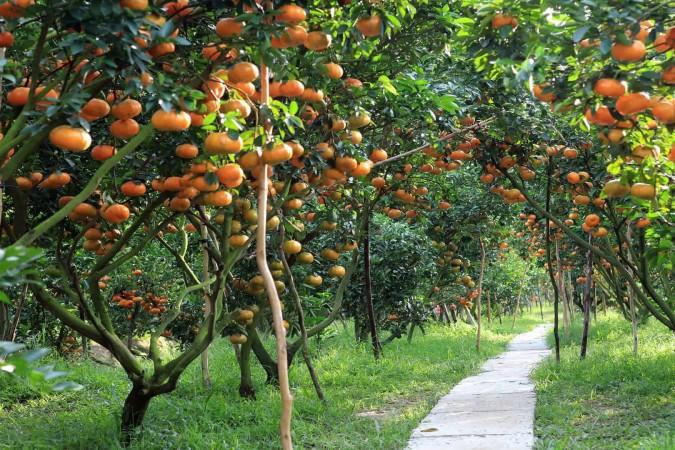
Orange Orchard in Cho Gao - © Vietnam Tourism
Weather in Cho Gao: Best Time to Visit
Cho Gao, located in the Mekong Delta, enjoys a tropical climate characterized by distinct wet and dry seasons. Understanding the weather conditions is essential for planning your visit, ensuring that you experience the best of what this charming district has to offer.
Cho Gao’s Climate
- Dry Season in Cho Gao: The dry season is the most popular time to visit Cho Gao. The weather is warm and mostly dry throughout these months, with average highs of 25°C to 30°C (77°F to 86°F). The skies are clear, making it ideal for outdoor activities like cycling tours, river cruises, and exploring local attractions.
- Wet Season in Cho Gao: The wet season brings frequent rain showers, particularly in the afternoons and evenings. While the rains can be heavy, they often do not last long. Temperatures during this period range from 24°C to 31°C (75°F to 88°F). Because of the copious amounts of rainfall, the terrain is lush and green, providing a unique yet equally lovely experience.
Best Time to Visit Cho Gao
December to February: This period offers the most comfortable weather, with cooler temperatures and minimal rainfall, making it perfect for sightseeing and outdoor adventures. It’s also the time when many local festivals take place, adding to the cultural experience.
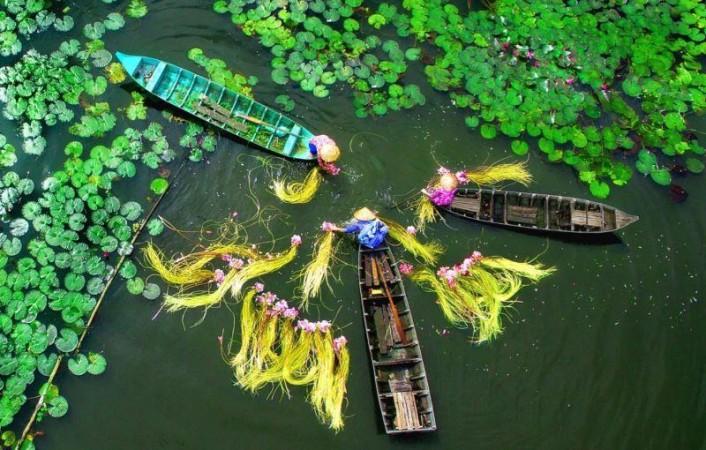
Wet season in Cho Gao - © CafeF
Essential Travel Information
Getting Around Cho Gao
Getting to Cho Gao
- By Road: Cho Gao is accessible by road from major cities like Ho Chi Minh City and My Tho. Buses and private cars are the most common means of reaching the district, with the journey from Ho Chi Minh City taking around 2 to 3 hours.
- By Boat: Given its location in the Mekong Delta, traveling by boat is also an option. River cruises often include Cho Gao as a stop, allowing you to arrive in style while enjoying the scenic beauty of the delta.
Local Transportation
- Motorbike Rental: Renting a motorbike is a popular way to explore Cho Gao at your own pace. The roads are generally safe and well-maintained, and a motorbike allows you to visit remote areas that may not be accessible by car.
- Cycling: For a more leisurely and eco-friendly option, consider renting a bicycle. The flat terrain and scenic countryside make cycling an enjoyable way to see the sights, particularly in rural areas where you can ride through rice paddies and fruit orchards.
- Taxis and Ride-Sharing: Taxis are readily available in Cho Gao, and ride-sharing services like Grab operate in the region. This is a convenient option for getting around, especially if you’re traveling with luggage or prefer not to drive yourself.
ATM & Banking Services
In Cho Gao, banking services and ATMs are readily available to cater to both locals and visitors. You'll find several ATMs throughout the town, especially in the center and near popular attractions, allowing withdrawals with both local and international cards. It's wise to carry some cash, as ATMs may be less accessible in rural areas. For more comprehensive banking needs, such as currency exchange or wire transfers, local bank branches can assist, though English proficiency may be limited. Cash remains the preferred payment method in markets, street vendors, and smaller shops.
Where to Stay in Cho Gao
- Mid-Range Hotels: For those seeking comfort without breaking the bank, Cho Gao has a selection of mid-range hotels that offer clean and comfortable rooms with modern amenities. These hotels frequently have Wi-Fi, air conditioning, and on-site restaurants.
- Local Homestays: Staying in a homestay is a great way to immerse yourself in the local culture. You’ll have the opportunity to live with a Vietnamese family, share meals, and learn about their way of life.
- Rural Homestays: For a more authentic experience, consider staying in a rural homestay outside the town center. These homestays often involve more rustic conditions but offer a unique glimpse into life in the Mekong Delta’s countryside.
Des articles pour vous

Explore Yala National Park - Sri Lanka Travel, Asia
Tucked away in Sri Lanka’s southeastern corner, Yala National Park is where wild nature meets deep tradition. Known worldwide for its leopard population, the park is also home to elephants, sloth bears, crocodiles, and hundreds of bird species. Beyond wildlife, Yala opens doors to a cultural landscape dotted with ancient temples, Buddhist ruins, and coastal villages. For travelers seeking more than just a safari, Yala offers a chance to explore eco-tourism, local communities, and sacred heritage sites.
Population: The Yala National Park area doesn’t have a human population.
Economy: The economy around Yala National Park thrives on a blend of eco-tourism, agriculture, and local services. Safari tours, eco-lodges, and cultural experiences drive steady income for nearby towns like Tissamaharama and Kataragama, supporting thousands of families.
Landmarks: Famous for Block I of Yala and wildlife encounters, including elephants, sloth bears, crocodiles, and exotic bird species.

Explore Galle - Sri Lanka Travel, Asia
Nestled on Sri Lanka’s southern coastline, Galle is a vibrant city where history meets the sea. Its cobbled streets, colonial architecture, and serene beaches make it a must-visit destination for travelers seeking a blend of culture, adventure, and relaxation. A UNESCO World Heritage site, Galle captivates visitors with its Dutch Fort, bustling markets, and friendly locals. Whether you’re exploring the ramparts at sunset or savoring fresh seafood by the shore, Galle promises an unforgettable journey into Sri Lanka’s heritage.
Population: Approximately 113,000 in 2023.
Economy: Galle’s economy thrives on tourism, trade, and fisheries. The city’s historic fort, colonial architecture, and coastal charm draw thousands of international visitors each year, making tourism its main economic driver. Fishing remains vital for local livelihoods, supplying fresh seafood across the region.
Landmarks: Famous for the Galle Fort, Dutch Reformed Church & Maritime Museum, and Unawatuna Beach.

Explore Bentota - Sri Lanka Travel, Asia
Nestled along Sri Lanka’s southwestern coast, Bentota is a tropical paradise that blends golden beaches, vibrant culture, and thrilling adventures. Famous for its calm waters, luxury resorts, and scenic river estuary, Bentota has become a top destination for travelers seeking both relaxation and authentic experiences. From serene beach walks at sunrise to adrenaline-pumping water sports, this coastal town offers a perfect balance of leisure and exploration. With its proximity to Colombo and Galle, Bentota is easy to reach, making it an ideal stop for both short escapes and extended holidays.
Population: Approximately 37,000 in 2023.
Economy: Bentota’s economy thrives mainly on tourism, which drives local businesses such as hotels, restaurants, and wellness retreats. The town also benefits from fishing, coconut cultivation, and handicrafts like wood carving and batik textiles. Many residents rely on the growing demand for water sports and Ayurvedic treatments, making tourism the backbone of both income and employment in the area.
Landmarks: Famous for Bentota Beach, Bentota River Safari, and Kande Vihara Temple.

Explore Mirissa - Sri Lanka Travel, Asia
Mirissa is a charming coastal town on Sri Lanka’s southern shoreline. Known for its golden beaches, turquoise waters, and vibrant marine life, it has become a must-visit stop for travelers exploring the island. Many come for whale watching, surfing, and sunset views at Coconut Tree Hill, but Mirissa offers much more than postcard beauty. The fishing boats you see anchored by the bay carry generations of stories. Local traditions, delicious cuisine, and a laid-back rhythm of life shape every visitor’s experience.
Population: Approximately 4,700 in 2023.
Economy: Mirissa’s economy is largely shaped by its coastal location. Fishing has long been the backbone of local livelihoods, with generations relying on the Indian Ocean for income. In recent decades, tourism has become the main driver of growth, thanks to whale watching, surfing, and beachside hospitality.
Landmarks: Famous for Mirissa Beach, Coconut Tree Hill, and Parrot Rock Bridge.

Explore Nuwara Eliya - Sri Lanka Travel, Asia
Tucked away in the Central Highlands of Sri Lanka, Nuwara Eliya is often called “Little England”. With its rolling tea plantations, cool misty mornings, and colonial charm, this mountain town feels like a step into another world. Travelers come here to breathe fresh air, walk through flower gardens, sip the finest Ceylon Tea, and enjoy a pace of life far from the island’s busy cities. Whether you’re drawn by scenic landscapes, heritage architecture, or the warmth of its people, Nuwara Eliya is a destination that blends nature, culture, and history in perfect harmony.
Population: Approximately 781,000 in 2023.
Economy: Nuwara Eliya’s economy thrives mainly on tea production, as it sits in the heart of Sri Lanka’s central highlands, famous worldwide for Ceylon Tea. The city also benefits from a growing tourism industry, attracting visitors with its colonial charm, cool climate, and scenic landscapes.
Landmarks: Famous for Gregory Lake, Hakgala Botanical Garden, and Victoria Park.

Explore Sukau - Malaysia Travel, Asia
Nestled on the banks of the Kinabatangan River in Sabah, Malaysian Borneo, Sukau is a destination where wildlife, culture, and conservation come together. Known as one of Asia’s top spots for river safaris and eco-tourism, this quiet village offers a front-row seat to encounters with Bornean orangutans, pygmy elephants, proboscis monkeys, and exotic birdlife.
Population: Approximately 1,400 in 2019.
Economy: Sukau’s economy is shaped by its riverine location and natural resources. Traditionally, the Orang Sungai community relied on fishing, small-scale farming, and forest gathering for their livelihood. Today, the village has shifted toward eco-tourism, with river cruises, jungle trekking, and homestays providing income.
Landmarks: Famous for the Kinabatangan River cruises, Gomantong Caves, and Ox-bow lakes and wetlands.
